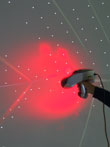
Among the joys of business are the unexpected directions it can take you. Protosys, a product development firm in Portugal, is a case in point. The company is discovering that its powerful reverse-engineering technology is suddenly in high demand by, surprisingly, the archaeology community.
Protosys, based in the heart of Porto, has an eight-year history of reverse-engineering. In a bid to move into larger products and new markets, it recently invested in a 3D laser scanner from Z Corporation. The handheld nature of the scanner, unique in its market, made it easy for Protosys to capture data from large complex surfaces like recreational boat hulls, providing uncompromisingly accurate digital models that solved traditional assembly problems.
What Protosys did not anticipate is that the scanner would turn out to be equally useful beyond engineering, specifically in archaeological and preservation projects.
Rapid, accurate marine design
Protosys is helping the boating industry in two main ways. First, it is helping manufacturers accelerate boat assembly and eliminate costly errors that force redesign. Boat hulls are traditionally made from fiberglass, and the designs are used for years. When manufacturers introduce new boat models, they reuse hull designs and spend the bulk of their product development efforts on the deck, cabin and furnishings. Since their moulds are based on handcrafted hull patterns, hulls are rife with minor imperfections. Minor imperfections add up, however, and can create headaches when a boat is assembled. When it’s time to glue the hull to the deck, too often the parts don’t fit together.

Protosys is helping boat manufacturers solve the problem by laser scanning the hulls and incorporating the data, flaws and all. It is using the ZScanner™ 700, the first handheld, self-positioning 3D scanner on the market that can digitize 3D surfaces in real time. Protosys imports the scan data as a digital model into its PowerSHAPE 3D CAD software. Designers and engineers can then use the CAD model, with its precise and actual dimensions, to work around any irregularities to ensure that the hull and deck fit together every time. Protosys finds this approach far superior to traditional measurement technologies that rely on cumbersome, fixed tripods and painstaking reassembly of virtual “slices” of an object.
Precision breeds confidence
“When prospective customers see the ZScanner’s precision at work, they trust us with their business. If there’s a flaw in their hull, we can detect it and model around it, catching aberrations that the eye or tape measure cannot,” says Alexandre Pinto Basto, product engineer/project manager at Protosys. “Once you’re in 3D, there’s no limit to what you can do.”

“It was astonishing what the ZScanner turned up,” said archaeologist Paulo Ramalho. “Its accuracy far exceeds that of the human hand, eye or brain, so it captured signs, symbols, pictures, numbers and letters we were missing. As a result, we obtained far more information than we could have developed ourselves and deepened our understanding of these ancient peoples’ lives, their territory, their movement, their habits and their religious practices.”

The city of Porto is brimming with such culturally significant ruins. Since practicality demands that some are sacrificed for development, capturing 3D data preserves them digitally and gives city officials an objective basis for sound decision-making.
“It’s not our core business or our original raison d’être, but preservation work is keeping us busy,” says Basto. “3D laser scanning lets us capture, with unparalleled accuracy, every contour of an artefact, and then bring it into the 3D data world, where it can be the subject of a virtual global archaeology study, repaired, printed, manufactured, or otherwise preserved and enjoyed.”
“The ZScanner was the only scanner that made sense for us because of its mobility, ease of use, light weight, affordability and self-referencing nature,” continues Basto. “It’s the only way to go out in the field to capture large objects, whether they’re boats or ancient relics, and obtain data that doesn’t require extensive repair. We’re convinced of its value, and so are our clients. One client even went out and bought his own ZScanner.”
For more infomation on this company click here










Zephyr high-altitude solar powered aircraft gears up for commercial service
Where is Zephyr launching from?